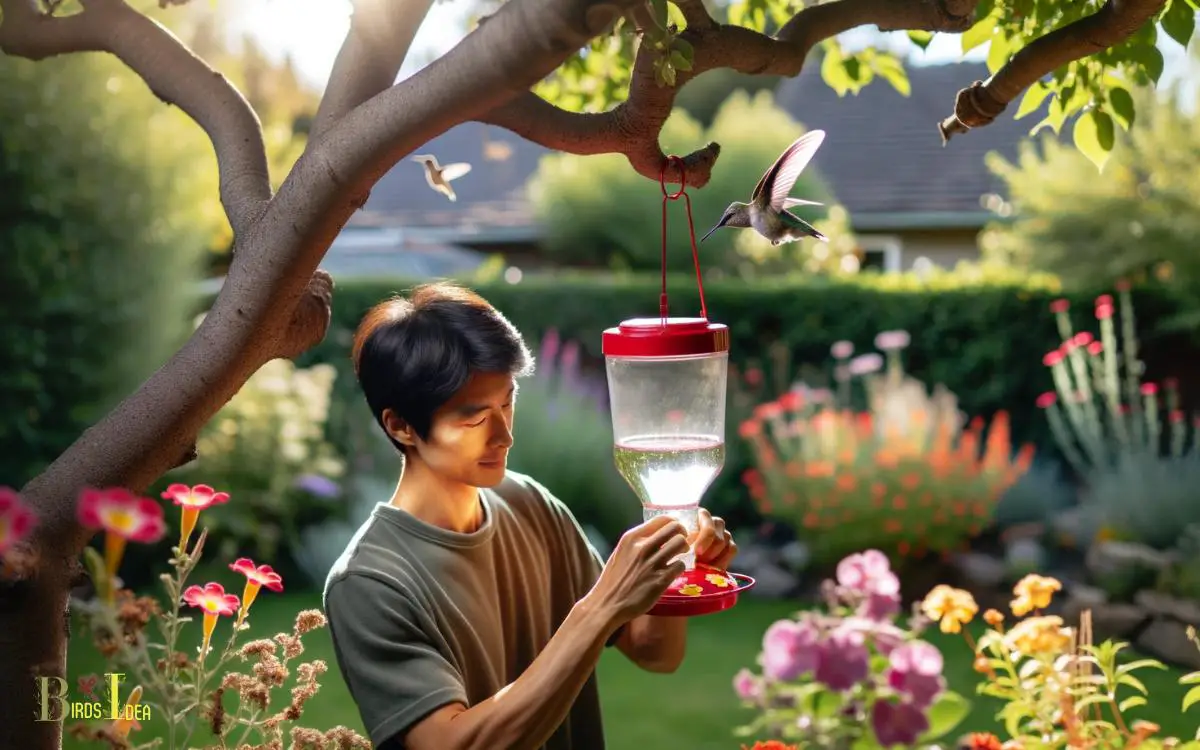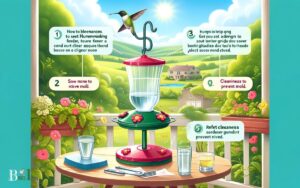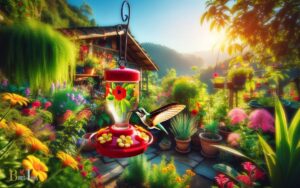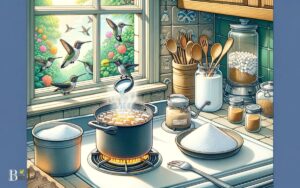How to Set Up a Hummingbird Feeder? 3 Easy Steps!
To set up a hummingbird feeder, choose a feeder with red accents, fill it with a sugar solution (four parts water to one part white sugar), and hang it in a shaded area near flowers.
Clean and refill the feeder regularly to prevent mold and attract hummingbirds.
Setting up a hummingbird feeder involves a few key steps:
Attract hummingbirds effortlessly with a well-maintained feeder – a simple joy that brings nature’s vibrancy to your garden.

Key Takeaway
Step 1: Choosing the Right Feeder
When setting up a hummingbird feeder, it is crucial to select the right feeder that meets the specific needs of these delicate birds.
Hummingbirds have distinct feeding habits and preferences, so choosing the right feeder is essential for attracting and serving these beautiful creatures.
Look for feeders with bright colors like red or orange, as these hues attract hummingbirds. Opt for feeders that are easy to clean, as cleanliness is vital for the health of the birds.
Additionally, consider the size and number of feeding ports on the feeder to accommodate the expected number of hummingbirds in your area.
By selecting a feeder that aligns with the needs of hummingbirds, you are taking a significant step in creating a welcoming environment for these enchanting birds.
Step 2: Mixing the Nectar Solution
Position the feeder near flowers, shrubs, or trees to offer natural perches and hiding spots for the birds.
To mix the nectar solution for your hummingbird feeder, use four parts water to one part white granulated sugar.
Boil the water first to remove impurities and then stir in the sugar until it dissolves. Let the solution cool before filling the feeder, and store any leftover nectar in the refrigerator for up to one week.
It’s essential to avoid using honey, artificial sweeteners, or food coloring, as these can be harmful to the birds.
Changing the nectar every 2-3 days, or more frequently in hot weather, will ensure its freshness and prevent the growth of harmful bacteria.
This simple nectar solution mimics the flowers hummingbirds naturally feed from and will attract these delightful birds to your feeder.
Step 3: Hanging and Mounting the Feeder
When setting up a hummingbird feeder, it is crucial to carefully consider the location where it will be hung. Choosing the right spot can attract more hummingbirds and ensure the safety of the birds.
Additionally, installing the feeder securely is essential to prevent it from falling and causing harm to the hummingbirds or other wildlife.
Choosing the Right Location
A suitable location for hanging or mounting the hummingbird feeder is essential for attracting and providing easy access to these vibrant birds.
When choosing a location for your feeder, consider the following:
- Safety: Ensure the feeder is placed away from areas with high human or pet traffic to prevent disturbances to the birds.
- Visibility: Position the feeder in a location where it can be easily seen from your home, allowing you to enjoy the beauty of the hummingbirds as they feed.
- Shelter: Provide some form of shelter, such as a nearby tree or shrub, to offer the birds protection from the elements.
- Accessibility: Hang or mount the feeder at a height that allows for easy refilling and cleaning, ensuring the birds always have a fresh supply of nectar.
Installing the Feeder Securely
To ensure the feeder is securely in place and stable, it should be hung from or mounted onto a sturdy and durable structure.
When hanging the feeder, use a strong hook or hanger that can support the weight of the feeder when filled with nectar.
Ensure that the hook is firmly attached to an overhead structure, such as a sturdy branch or a hook attached to a beam or eave.
If mounting the feeder onto a pole or post, use a secure mounting bracket to keep it stable. It’s important to place the feeder in a location that is easily accessible for refilling and cleaning, but also out of reach of predators.
Once the feeder is securely installed, it’s essential to maintain and clean it regularly to ensure the health and safety of the hummingbirds.
Maintaining and Cleaning the Feeder
Proper maintenance and cleaning of your hummingbird feeder is essential to ensure the health and safety of the birds.
This includes establishing a regular cleaning schedule and using appropriate cleaning methods to prevent the growth of mold and bacteria.
Additionally, understanding safe cleaning solutions will help you maintain a clean and healthy environment for the hummingbirds.
Cleaning Schedule and Methods
To maintain cleanliness and ensure the health of the hummingbirds, it is essential to establish a regular cleaning schedule for the feeder.
Here are some cleaning methods and a schedule to maintain the feeder:
- Regularly clean the feeder with hot water and a bottle brush.
- Use a mild soap solution to remove any mold or residue.
- Rinse the feeder thoroughly after cleaning to ensure no soap residue remains.
- Allow the feeder to air dry completely before refilling it with fresh nectar.
By following these cleaning methods and schedule, you can ensure that the hummingbirds have access to a clean and safe feeding environment, promoting their health and well-being.
Now, let’s move on to discussing methods for preventing mold and bacteria in the feeder.
Preventing Mold and Bacteria
Regularly cleaning the feeder with hot water and a mild soap solution is essential for preventing mold and bacteria and maintaining a healthy environment for hummingbirds.
Mold and bacteria can quickly develop in the sugar solution, especially in warm weather. To prevent this, it’s crucial to clean the feeder at least every three to four days, or more frequently if the weather is particularly warm.
When cleaning the feeder, disassemble it completely and wash all parts thoroughly with the hot water and mild soap solution.
Use a small brush to scrub the feeding ports and any other hard-to-reach areas. Rinse the feeder well with hot water to ensure that no soap residue remains.
Additionally, always remember to refill the feeder with fresh nectar after cleaning to keep the hummingbirds coming back to a safe and healthy environment.
Safe Cleaning Solutions
To maintain a healthy environment for hummingbirds and prevent the growth of mold and bacteria, it is important to use safe cleaning solutions while maintaining and cleaning the feeder. When choosing cleaning solutions, consider the following:
- Use a mixture of 1 part white vinegar to 4 parts water for regular cleaning.
- Avoid using soap, bleach, or other harsh chemicals as they can be harmful to hummingbirds.
- Rinse the feeder thoroughly with hot water after cleaning to ensure the removal of any cleaning solution residue.
- Clean the feeder at least once a week, or more frequently in hot weather to prevent the growth of harmful bacteria.
Attracting Hummingbirds to the Feeder
One effective way to attract hummingbirds to the feeder is by using a brightly colored, nectar-filled container.
The color red, in particular, tends to catch the attention of hummingbirds. Choose a feeder that has red accents or is predominantly red, as this color resembles the vibrant flowers that hummingbirds are naturally drawn to.
Additionally, planting bright, nectar-producing flowers in the vicinity of the feeder can further entice these delicate birds.
Providing a consistent source of fresh, clean nectar is essential for attracting and retaining hummingbirds. It’s important to regularly refill the feeder with a homemade or store-bought nectar solution, and to keep the feeder clean to prevent mold and mildew growth.
By creating an inviting and nourishing environment, you can attract and support these beautiful creatures in their natural habitat.
Can I Use the Same Steps to Set Up a Hummingbird Feeder for Mixing Hummingbird Nectar Concentrate?
Setting up a hummingbird feeder with easy steps hummingbird nectar concentrate is simple. Begin by selecting a suitable location, preferably near flowers or shrubs. Mix the nectar concentrate as instructed on the package, ensuring the right ratio of water and concentrate. Fill the feeder with the mixture, hang it securely, and clean it regularly to maintain a healthy feeding station for these delightful birds.
Troubleshooting Common Issues
Addressing a hummingbird feeder’s common issues requires a thorough understanding of the birds’ behavior and feeder maintenance.
By being attentive to potential problems, you can ensure that your feeder continues to attract and nourish these delightful creatures.
Here are some common issues and their solutions:
- Leaking Nectar: Ensure that the feeder is tightly sealed to prevent leaks and attract unwanted insects.
- Moldy Nectar: Regularly clean the feeder with a mild solution of vinegar and water to prevent mold growth.
- Bee or Wasp Infestation: Place bee guards or wasp traps near the feeder to deter these insects without harming the hummingbirds.
- Lack of Hummingbird Visits: Check for nearby distractions, such as brightly colored objects or noisy surroundings, and relocate the feeder if necessary.
Conclusion
Setting up a hummingbird feeder requires careful consideration of the feeder type, location, nectar solution, and maintenance.
By choosing the right feeder and placing it in an ideal location, mixing the nectar solution, and regularly cleaning the feeder, you can attract hummingbirds to your yard and enjoy their presence.
Troubleshooting common issues will ensure that the feeder continues to attract these beautiful and vibrant birds for years to come.






